The X Button
Fields of Fire
by Todd Ciolek,

The latest broad estimates from Square Enix suggest that a Final Fantasy XIII demo won't be out until March 2009, and that the game itself probably won't arrive until next summer at the earliest. This means that it may be well over a year until North American critics get to review a domestic version of the game.
Well, I'm not going to wait. I'm going to take the latest batch of Final Fantasy XIII images and review them. Try and stop me, Square.

This scene of Lightning (left) and Snow (right) conversing about the city of Cocoon is caught between portraying the characters and showcasing the background. It does neither well. Good idea, flawed execution. 6/10.
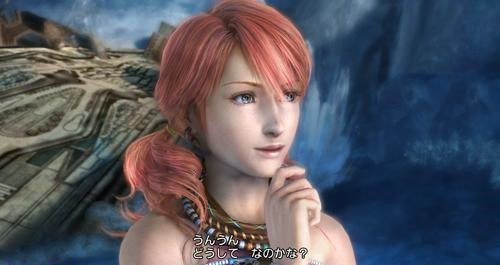
See, this is the sort of waxen, unemotional expression that Final Fantasy games need to escape. Past games have often used stilted-looking characters in CG, and one would hope that the PlayStation3 would allow greater detail than we see on Sera's face here. Two out of five stars.
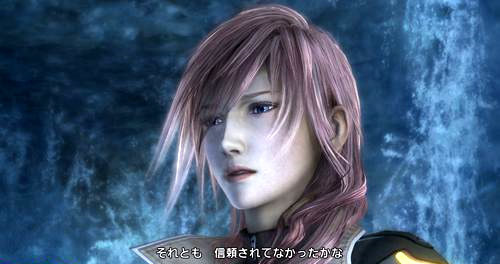
A noticeable improvement on the Sera shot, this image shows Lightning expressing some emotion other than mannequin-like interest. Nice hair texture as well. 7.65 out of 10 (not an average).
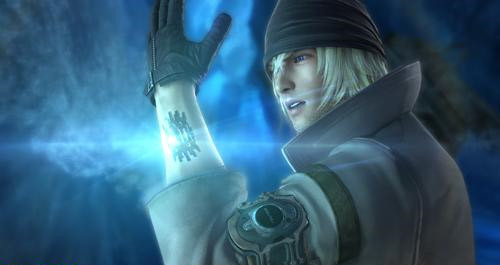
Every Final Fantasy needs a dozen or so magical glowing MacGuffins, and one of them is a tattoo that Snow wears and apparently never looked at too closely before this scene. It's pretty but offers no innovation. B-.
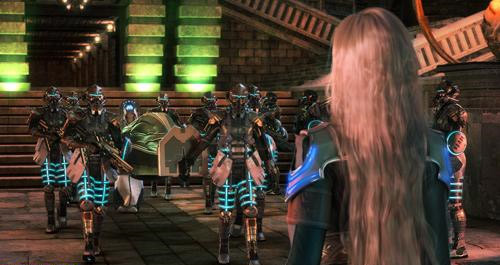
Now here's a shot that raises questions, and it does so by showing a bunch of guards wearing glowing pants while shepherding a coffin or some other important container. And is that Lightning watching them? It's someone important, because Square would never waste that hair on a throwaway character. This gets a happy face for “Fun Factor.”
NEWS
THE OTHER FINAL FANTASY XIIIS SHOW UP
In other Final Fantasy XIII developments, Square announced the full names of the leads in the alleged action-RPG Final Fantasy Versus XIII. The man is Noctis Lucius Caelum, scion of a crime family that protects an all-new version of those crystals that show up in every Final Fantasy game. The woman is Stella Nox Fleuret, who's both Noctis' sworn mobster enemy and his apparent love interest. Ain't they cute?
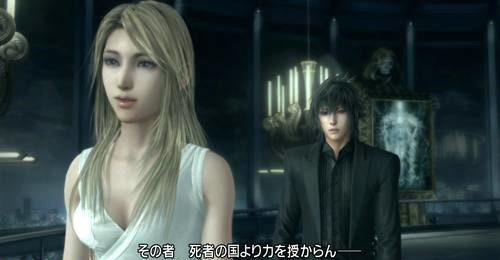
We've also seen new screens of Final Fantasy XIII Agito, including images of a battle system that appears much like the typical menu-based RPG interface.
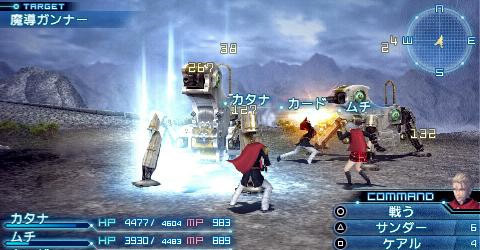
However, it'll supposedly play more like the free-roaming Crisis Core, with a wide variety of uniquely armed students to control during combat. I wouldn't be surprised if Agito uses the same graphics engine as Crisis Core. It's certainly pretty enough for that.
YS BOOK I AND II ON DS
The Ys series has the habit of popping up when you least expect it. Konami surprised a few by releasing Ys VI: The Ark of Naphistim for the PlayStation 2 and PSP in the U.S. a few years ago, and the Ys Book I and II compilation made its debut on the Wii's Virtual Console in August. Atlus has the latest shock: a U.S. release for the DS remakes of Ys I and II. Though they were offered separately in Japan, there, Atlus is packing both games onto one set, just as NEC and Hudson did with Ys Book I and II all those years ago. Here's the official trailer from Atlus.
Yet this isn't without problems. See, the earlier Ys games had a battle system wherein Adol, the hero, simply walked into enemies and either damaged them or took damage himself. It was a primitive setup that needed to be updated, but instead of implementing a Zelda-style sword-swinging attack, the DS remakes make the player press an attack button just as Adol touches an enemy. No one who played the Japanese versions of the Ys remakes liked it, and they're all hoping that Atlus changes it for the U.S. version when it hits early next year.
MEDIA VISION DANCES ON BAUM'S SPINNING GRAVE WITH RIZ-ZOAWD
 L. Frank Baum's The Wonderful Wizard of Oz passed into the public domain back in 1956, but it took decades for a Japanese game developer to seize upon this and create a DS RPG based on Dorothy's adventures in political allegory.
L. Frank Baum's The Wonderful Wizard of Oz passed into the public domain back in 1956, but it took decades for a Japanese game developer to seize upon this and create a DS RPG based on Dorothy's adventures in political allegory.
Riz-zoawd, currently in the works at Media Vision (which also made the Wild Arms series), turns the tale into a 3-D RPG. The Scarecrow wields a guitar and the witches look like magical-girl icons, but the whole thing seems a little more faithful to Baum's vision than, say, Dorothy of Oz. Players spur Dorothy along by scratching the DS stylus across a track-ball on the lower screen, and the battles use the familiar first-person view that Dragon Quest will never abandon. There's no word on a U.S. release, but domestic publishers might be tempted by a familiar license that won't incur heavy charges.
WEIRD-ASS IMPORT ROUNDUP: OCTOBER
CYBER MAID ALICE You'll also find a video of talk-show hosts poking a flustered Alice while real women look on, laughing as a digital maid is stripped of her uniform and her dignity. If you've ever wondered how Japan got the reputation it has today, Cyber Maid Alice is all the answer you'll need.
|
SUPER ROBOT WARS Z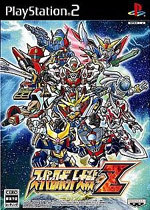 With over a dozen games in the Super Robot Wars series (forever known in the West as Super Robot Taisen due to pesky copyrights), Z doesn't seem all that strange for collecting robots from the anime world and slapping them into a strategy-RPG. Yet this is easily the biggest Super Robot Wars game in years, and I can't name a 2008 Japanese release that anime fans are more likely to import (except possibly Tatsunoko vs. Capcom). It plays much like previous SRW titles: move your super-deformed units around an overhead map, then watch as all of your favorite giant robots from Gundam and Orguss and Eureka Seven deal out marvelously excessive attacks. Allegedly the start of a new sub-series, Z raises its animation to new heights, both for the original mecha and the lineup of familiar robots from over 22 different shows. There's also a new and thoroughly ignorable storyline; two of them, in fact. One selectable path stars the stylishly coiffed Rand Travis, his yippy mechanic Mail Beater, and their glitzy, wrench-swinging super robot Gunleon (complete with its own theme songs). The other story route features the reluctant, oh-when-does-the-killing-stop pilot Setsuko Ohara, her teammates, and a military mecha called the Balgora. With over a dozen games in the Super Robot Wars series (forever known in the West as Super Robot Taisen due to pesky copyrights), Z doesn't seem all that strange for collecting robots from the anime world and slapping them into a strategy-RPG. Yet this is easily the biggest Super Robot Wars game in years, and I can't name a 2008 Japanese release that anime fans are more likely to import (except possibly Tatsunoko vs. Capcom). It plays much like previous SRW titles: move your super-deformed units around an overhead map, then watch as all of your favorite giant robots from Gundam and Orguss and Eureka Seven deal out marvelously excessive attacks. Allegedly the start of a new sub-series, Z raises its animation to new heights, both for the original mecha and the lineup of familiar robots from over 22 different shows. There's also a new and thoroughly ignorable storyline; two of them, in fact. One selectable path stars the stylishly coiffed Rand Travis, his yippy mechanic Mail Beater, and their glitzy, wrench-swinging super robot Gunleon (complete with its own theme songs). The other story route features the reluctant, oh-when-does-the-killing-stop pilot Setsuko Ohara, her teammates, and a military mecha called the Balgora. Odds of a Domestic Release: Not good, considering the massive pile of licenses involved. But hey, we might get Super Robot Taisen: Endless Frontier instead. |
YUUSHA NO KUZE NI NAMAIKIDA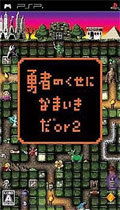 The original Yuusha no Kuze ni Namaikida presented yet another reversal of game conventions, as it tasked the player with protecting a small monster by building a dungeon around it. In a graphically basic interface that allowed for easy customization, the player digs out a cavern from a screen full of square blocks. This releases small slime creatures which create larger monsters, all to destroy the allegedly heroic adventurers who enter the dungeon to slay your demonic little charge. Those dungeons can grow huge, with all sorts of creatures and traps to be found, and the sequel adds more monster variety and new dungeon design methods. One can't help thinking that dungeon creation would work better on the DS, but the PSP needs its rebellious genre-breakers, too. The original Yuusha no Kuze ni Namaikida presented yet another reversal of game conventions, as it tasked the player with protecting a small monster by building a dungeon around it. In a graphically basic interface that allowed for easy customization, the player digs out a cavern from a screen full of square blocks. This releases small slime creatures which create larger monsters, all to destroy the allegedly heroic adventurers who enter the dungeon to slay your demonic little charge. Those dungeons can grow huge, with all sorts of creatures and traps to be found, and the sequel adds more monster variety and new dungeon design methods. One can't help thinking that dungeon creation would work better on the DS, but the PSP needs its rebellious genre-breakers, too. Odds of a Domestic Release: Not bad, actually. Rumors suggest that it might come here under the title Destroy All Heroes.
|
RELEASES FOR THE WEEK OF 11-2
DRAGON BALL Z: INFINITE WORLD
|
|
DRAGON BALL ORIGINS (Atari/Namco Bandai, DS, $29.99)  For those who prefer the nonsense, juvenile humor, and plot progression of Akira Toriyama's Dragon Ball series, there's the action-RPG Dragon Ball Origins. Spanning the early years of Goku, the game puts him in the middle of overhead levels, wherein players manipulate him into combat against dinosaurs and other enemies from the first few seasons of the Dragon Ball anime. Gameplay's mostly based around the stylus, as it guides him around the lower screen and taps to make him strike. The game's 3-D visuals also do a surprisingly good job of imitating the Dragon Ball storyline, right down to the scene where Bulma flashes her delicate regions at Master Roshi. Don't be surprised if that part's censored, though I doubt they'll change underwear to sandwiches like they did in the Dragon Ball NES game. For those who prefer the nonsense, juvenile humor, and plot progression of Akira Toriyama's Dragon Ball series, there's the action-RPG Dragon Ball Origins. Spanning the early years of Goku, the game puts him in the middle of overhead levels, wherein players manipulate him into combat against dinosaurs and other enemies from the first few seasons of the Dragon Ball anime. Gameplay's mostly based around the stylus, as it guides him around the lower screen and taps to make him strike. The game's 3-D visuals also do a surprisingly good job of imitating the Dragon Ball storyline, right down to the scene where Bulma flashes her delicate regions at Master Roshi. Don't be surprised if that part's censored, though I doubt they'll change underwear to sandwiches like they did in the Dragon Ball NES game. Get Excited If: You've always through of Dragon Ball as Z's overlooked yet superior little brother.
|
|
NARUTO ULTIMATE NINJA STORM (Namco Bandai, PS3, $59.99/$69.99) 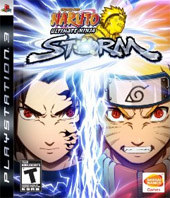 Yes, we know that Naruto is currently in a race with Dragon Ball Z to see which franchise can put fighting games on every system. Yet this one claims some new territory by...well, by looking really good. The 3-D battle system isn't terribly far removed from the Ultimate Ninja fighters seen on the PS2, but the developers have concentrated long and hard on making the game look indistinguishable from a well-animated episode of the TV series, provided that the TV series had life bars and other status indicators on the screen. They've come remarkably close to that goal, and the programmers seem to have refined the play mechanics from previous Ultimate Ninja titles. For the true Naruto lunatic, there's a special edition with a steelbook case, a soundtrack, and a “laser cel,” which I dearly hope shoots actual lasers. Yes, we know that Naruto is currently in a race with Dragon Ball Z to see which franchise can put fighting games on every system. Yet this one claims some new territory by...well, by looking really good. The 3-D battle system isn't terribly far removed from the Ultimate Ninja fighters seen on the PS2, but the developers have concentrated long and hard on making the game look indistinguishable from a well-animated episode of the TV series, provided that the TV series had life bars and other status indicators on the screen. They've come remarkably close to that goal, and the programmers seem to have refined the play mechanics from previous Ultimate Ninja titles. For the true Naruto lunatic, there's a special edition with a steelbook case, a soundtrack, and a “laser cel,” which I dearly hope shoots actual lasers. Get Excited If: You're waiting for Naruto to come out on Blu-Ray.
|
|
VALKYRIA CHRONICLES (Sega, PS3, $59.99)  The PlayStation 3 has little in the way of Japanese RPGs, and Sega's had little in the way of interesting new franchises for the past five years. Valkyria Chronicles tries to solve both problems with its combination of strategic action and captivating watercolor-like visuals. The game has a lush, painted look that too many people are lazily comparing to Ghibli movies, even if Valkyria's nation of Gallia does indeed take place in the same gentle corner of pre-war Europe that Miyazaki likes to think actually existed. Before long, the verdant hills of Gallia are overrun by the East European Imperial Alliance, and local kids Welkin Gunther and Alicia Melchiott form their own guerrilla squad to repel the invaders (and fall for each other). Soldiers' positions are laid out on a strategy grid, but their up-close movements are in fully 3-D battlefields, where characters move and attack as they would in an action game (albeit one where points limit activity). Welkin and Alicia's pocket war includes medics, scouts, snipers, artillery, tanks, and perhaps even the powers of the mythic Valkyria. Their ranks also feature Skies of Arcadia's Vyse and Aika, and I plan on immediately marching both of them in front of the nearest enemy tank. The PlayStation 3 has little in the way of Japanese RPGs, and Sega's had little in the way of interesting new franchises for the past five years. Valkyria Chronicles tries to solve both problems with its combination of strategic action and captivating watercolor-like visuals. The game has a lush, painted look that too many people are lazily comparing to Ghibli movies, even if Valkyria's nation of Gallia does indeed take place in the same gentle corner of pre-war Europe that Miyazaki likes to think actually existed. Before long, the verdant hills of Gallia are overrun by the East European Imperial Alliance, and local kids Welkin Gunther and Alicia Melchiott form their own guerrilla squad to repel the invaders (and fall for each other). Soldiers' positions are laid out on a strategy grid, but their up-close movements are in fully 3-D battlefields, where characters move and attack as they would in an action game (albeit one where points limit activity). Welkin and Alicia's pocket war includes medics, scouts, snipers, artillery, tanks, and perhaps even the powers of the mythic Valkyria. Their ranks also feature Skies of Arcadia's Vyse and Aika, and I plan on immediately marching both of them in front of the nearest enemy tank. Get Excited If: You've ever wanted to play a strategy-RPG and a World War II shooter at the same time.
|
|
Speaking of Naruto... Here's something promoting the recent release of Clash of the Ninja 2
|
EXTRA LIVES: YU YU HAKUSHO
 When Treasure's Gunstar Heroes arrived on the Genesis in 1993, many easily won-over critics praised it as the debut of a fantastic new developer, one unhindered by petty corporate dictates or slavish titles based on popular franchises. That idea evaporated with Treasure's second game: McDonald's Treasure Land Adventure. Yes, Treasure clearly needs to eat and pay rent and fund their more experimental games, just like any other company. The difference is that Treasure's licensed games occasionally reach beyond their bill-paying drudgery and explore unique ideas. Yu Yu Hakusho: Makyo Toitsusen was their first good game based on an anime series, and it laid the foundation for more like it.
When Treasure's Gunstar Heroes arrived on the Genesis in 1993, many easily won-over critics praised it as the debut of a fantastic new developer, one unhindered by petty corporate dictates or slavish titles based on popular franchises. That idea evaporated with Treasure's second game: McDonald's Treasure Land Adventure. Yes, Treasure clearly needs to eat and pay rent and fund their more experimental games, just like any other company. The difference is that Treasure's licensed games occasionally reach beyond their bill-paying drudgery and explore unique ideas. Yu Yu Hakusho: Makyo Toitsusen was their first good game based on an anime series, and it laid the foundation for more like it.
By 1994 the industry was still in the thick of the fighting-game panic sparked by Street Fighter II, and most of the copycats played by the same rules: two warriors punched and kicked on a 2-D plane until one of them collapsed. Four-player fighting games existed, but they were terribly simple. Treasure saw no need to choose between the two worlds, and their Yu Yu Hakusho fighter for the Mega Drive (the Japanese Genesis for those of you playing along) let four characters clash on the screen at once. It's still a 2-D fighter, but one with foreground and background planes that fighters can jump between.
 Treasure also needed to change a few of the rules. The game's dozen or so characters have sizeable arsenals of moves, and most are performed with forward rolling “fireball” motions and direction taps that make it easy for characters to switch directions. Special moves deplete an energy bar, and holding down two buttons charges it back up. Each fighter also gets one extra-powerful move: Kurama turns into his even-prettier fox form, Hiei throws a huge fiery dragon, and so forth. These attacks eat up almost an entire energy meter, but they're also capable of knocking off half of an opponent's life.
Treasure also needed to change a few of the rules. The game's dozen or so characters have sizeable arsenals of moves, and most are performed with forward rolling “fireball” motions and direction taps that make it easy for characters to switch directions. Special moves deplete an energy bar, and holding down two buttons charges it back up. Each fighter also gets one extra-powerful move: Kurama turns into his even-prettier fox form, Hiei throws a huge fiery dragon, and so forth. These attacks eat up almost an entire energy meter, but they're also capable of knocking off half of an opponent's life.
Yu Yu Hakusho is exceptionally solid as a multi-player fighting game, with tournament modes, a single-player quest, and a mode for quick and dirty free-for-alls. Yet it doesn't make more than a cursory effort to capture the story of Yoshihiro Togashi's manga and its anime spawn. There's no story mode to speak of, few appearances by Yu Yu Hakusho's supporting cast, and even the intro just shows in-game footage of the characters pounding each other. Treasure concentrated on making the actual gameplay faithful to the series, with lots of voice samples and anime-accurate attacks.
The constraints of a four-player fighter leave Yu Yu Hakusho with little in the way of jaw-dropping visuals. The characters are fairly small in order to allow four of them in a single stage, and the backgrounds try to compensate for frequently boring scenery with changes in lighting. The soundtrack's bland, and most of the voicework sounds scratchy. It's impressive for a Genesis game, but we're nearly fifteen years past that age.
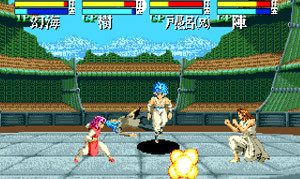 And Treasure would use Yu Yu Hakusho's ideas again. Their first Sega Saturn game, Guardian Heroes, borrowed the multi-planar approach and simplified special moves, making it one of the most satisfying games on the system (especially in the six-player versus mode). Most recently, Treasure put the same concepts to work in two fighters based on Bleach, Yu Yu Hakusho's spiritual descendent.
And Treasure would use Yu Yu Hakusho's ideas again. Their first Sega Saturn game, Guardian Heroes, borrowed the multi-planar approach and simplified special moves, making it one of the most satisfying games on the system (especially in the six-player versus mode). Most recently, Treasure put the same concepts to work in two fighters based on Bleach, Yu Yu Hakusho's spiritual descendent.
That's Yu Yu Hakusho's biggest flaw: it's engaging, but Treasure's Bleach fighters eclipse it in character lineups, in gameplay, and even in visual appeal. Treasure's first anime-based game was well worth checking out in its day (when imported games cost about $120), and it's still a nice attraction for Yu Yu Hakusho fans with three friends. Just don't expect it to outdo its descendants.
Hunting down a physical copy of Yu Yu Hakusho for the Mega Drive will bring you face to face with the pricey world of Treasure game collecting. Treasure turns profits by keeping production runs small, and Yu Yu Hakusho is scarce enough to run about $60 for a complete copy. Just make sure you grab Makyo Toitsusen and not Sega's cheaper (and duller) Yu Yu Hakusho Gaiden.
discuss this in the forum (62 posts) |
this article has been modified since it was originally posted; see change history
 You might think that Japan's subculture of maids and moe has reached its nadir, that it has left no territory unexplored when it comes to fetishizing and degrading fictional women. Yet Gekisha Tokyo Entertainment has indeed broken new ground with Cyber Maid Alice, a virtual maid program of indescribable horror for computers. Here's how it works: load the software, set up your webcam, position a cube on your desk, and watch as the three-inch-tall Alice shows up on your computer screen. You can interact with her by maneuvering the specialized plastic sticks and boxes in reality, and the virtual Alice will react accordingly. Of course, the company's definition of “interact” is just as disturbing as you'd expect. Users can suggestively prod Alice and make her clothing disappear, causing her to squeal out rebukes at her “master” until she's reduced to a terrified, sobbing wreck. Then you can give her presents to make it all better! Lest you think I'm making any of this up, here's a video from the makers of Cyber Maid Alice, showing both their creative use of technology and a stunning new low for Japanese nerds.
You might think that Japan's subculture of maids and moe has reached its nadir, that it has left no territory unexplored when it comes to fetishizing and degrading fictional women. Yet Gekisha Tokyo Entertainment has indeed broken new ground with Cyber Maid Alice, a virtual maid program of indescribable horror for computers. Here's how it works: load the software, set up your webcam, position a cube on your desk, and watch as the three-inch-tall Alice shows up on your computer screen. You can interact with her by maneuvering the specialized plastic sticks and boxes in reality, and the virtual Alice will react accordingly. Of course, the company's definition of “interact” is just as disturbing as you'd expect. Users can suggestively prod Alice and make her clothing disappear, causing her to squeal out rebukes at her “master” until she's reduced to a terrified, sobbing wreck. Then you can give her presents to make it all better! Lest you think I'm making any of this up, here's a video from the makers of Cyber Maid Alice, showing both their creative use of technology and a stunning new low for Japanese nerds.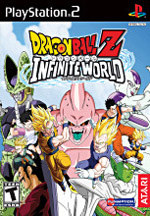 Yes, it's another Dragon Ball Z fighting game. Namco Bandai and Atari re-issued three older DBZ fighters in a single set earlier this year, just in case you forgot about them, but that was all a warm-up for Infinite World, which builds on the fighting engine of the Budokai series. It has a “capsule” customization system similar to the fighter-tweaking seen in previous games, and there's also a series of Dragon Missions, which are what they're apparently calling mini-games that recreate moments from the anime series. These challenges include a race down Snake Way and the epic contest to catch King Kai's pet monkey, and you'll often have to complete them before taking part in traditional battles. Of course, there's also a huge roster of characters and a versus mode to turn to when you're tired of mini-games, but that almost goes without saying.
Yes, it's another Dragon Ball Z fighting game. Namco Bandai and Atari re-issued three older DBZ fighters in a single set earlier this year, just in case you forgot about them, but that was all a warm-up for Infinite World, which builds on the fighting engine of the Budokai series. It has a “capsule” customization system similar to the fighter-tweaking seen in previous games, and there's also a series of Dragon Missions, which are what they're apparently calling mini-games that recreate moments from the anime series. These challenges include a race down Snake Way and the epic contest to catch King Kai's pet monkey, and you'll often have to complete them before taking part in traditional battles. Of course, there's also a huge roster of characters and a versus mode to turn to when you're tired of mini-games, but that almost goes without saying.